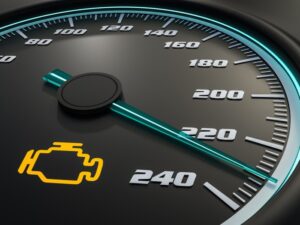
The check engine light in your Hyundai can be a cause for concern, but it doesn’t always indicate a major problem. However, it’s important to address the issue promptly to prevent any potential damage to your vehicle. In this article, we will explore the common reasons why the check engine light illuminates in Hyundai vehicles and provide troubleshooting steps and possible solutions to help you resolve the issue.
Understanding the Check Engine Light
The check engine light, also known as the malfunction indicator lamp (MIL), is an important feature in modern vehicles. It is designed to alert the driver when the vehicle’s onboard diagnostic system detects a potential issue with the engine or emissions system. When the check engine light illuminates, it means that the vehicle’s computer has stored a fault code related to the detected problem.
Common Causes of Check Engine Light in Hyundai
Several factors can trigger the check engine light in Hyundai vehicles. Here are some of the most common causes:
2.1 Faulty Oxygen Sensor
The oxygen sensor plays a crucial role in monitoring the level of oxygen in the exhaust system. A malfunctioning oxygen sensor can lead to poor fuel efficiency and increased emissions, triggering the check engine light.
2.2 Loose or Faulty Gas Cap
A loose or faulty gas cap can result in fuel vapor leakage and disrupt the proper functioning of the evaporative emission control system. This can cause the check engine light to illuminate.
2.3 Catalytic Converter Issues
A damaged or failing catalytic converter can trigger the check engine light. The catalytic converter is responsible for reducing harmful emissions, and any issues with it can affect the overall performance of the vehicle.
2.4 Malfunctioning Mass Airflow Sensor
The mass airflow sensor measures the amount of air entering the engine to ensure the correct air-fuel mixture. A faulty sensor can cause engine performance issues and activate the check engine light.
2.5 Spark Plug Problems
Worn-out or faulty spark plugs can lead to misfires, reduced engine performance, and increased emissions. The check engine light may illuminate to indicate a problem with the spark plugs.
2.6 Faulty Ignition Coil
The ignition coil is responsible for generating the high voltage required to ignite the air-fuel mixture in the combustion chamber. A faulty ignition coil can result in engine misfires and trigger the check engine light.
2.7 Issues with the Exhaust Gas Recirculation (EGR) Valve
The EGR valve recirculates a portion of the exhaust gases back into the intake manifold to reduce nitrogen oxide emissions. If the EGR valve is clogged or malfunctioning, it can cause the check engine light to turn on.
2.8 Problems with the Evaporative Emission Control System
Issues with the evaporative emission control system, such as a faulty purge valve or leaky hoses, can trigger the check engine light. The system is responsible for preventing the release of fuel vapors into the atmosphere.
2.9 Faulty Engine Control Module (ECM)
The engine control module (ECM), also known as the engine control unit (ECU), is the computer that controls various engine functions. A malfunctioning ECM can lead to inaccurate sensor readings and activate the check engine light.
2.10 Wiring or Electrical Issues
Poor wiring connections, damaged cables, or electrical problems can interfere with the proper operation of various engine components. These issues can trigger the check engine light.
2.11 Other Potential Causes
There are several other potential causes for the check engine light to illuminate, including a faulty thermostat, vacuum leaks, fuel injector problems, or issues with the ignition system.
Steps to Troubleshoot the Check Engine Light
If the check engine light comes on in your Hyundai, you can follow these steps to troubleshoot the issue:
3.1 Check for a Loose Gas Cap
Start by checking the gas cap to ensure it is tightly sealed. A loose gas cap is a common cause of the check engine light turning on.
3.2 Inspect the Oxygen Sensor
If the gas cap is secure, you can inspect the oxygen sensor for any visible damage or signs of wear. A faulty oxygen sensor may need to be replaced.
3.3 Examine the Mass Airflow Sensor
Inspect the mass airflow sensor for dirt, debris, or damage. Cleaning or replacing the mass airflow sensor may be necessary to resolve the issue.
3.4 Check the Spark Plugs and Ignition Coils
Inspect the spark plugs for signs of wear or fouling. Additionally, check the ignition coils for any visible damage. Replace any faulty spark plugs or ignition coils as needed.
3.5 Inspect the Catalytic Converter
Examine the catalytic converter for any physical damage or clogging. A damaged catalytic converter may require replacement to resolve the check engine light issue.
3.6 Check the EGR Valve
Inspect the EGR valve for any carbon buildup or sticking. Cleaning or replacing the EGR valve may be necessary to address the check engine light.
3.7 Inspect the Evaporative Emission Control System
Check the hoses and connections of the evaporative emission control system for leaks or damage. Repair or replace any faulty components to resolve the check engine light issue.
3.8 Scan the Engine Control Module (ECM)
Using an OBD-II scanner, retrieve the fault codes stored in the ECM. The codes will provide more specific information about the issue, helping you pinpoint the cause of the check engine light.
3.9 Examine the Wiring and Electrical Connections
Carefully inspect the wiring harnesses and electrical connections related to the engine components. Ensure that all connections are secure and free from damage.
3.10 Seek Professional Assistance
If you are unable to identify or resolve the issue on your own, it is recommended to seek professional assistance from a qualified mechanic or Hyundai dealership. They have the expertise and diagnostic equipment to accurately diagnose and repair the problem.
Common FAQs About Hyundai Check Engine Light
4.1 What should I do if the check engine light flashes?
If the check engine light is flashing, it indicates a severe problem that requires immediate attention. It is advisable to pull over safely and have the vehicle towed to a professional for diagnosis and repair.
4.2 Can I drive my Hyundai with the check engine light on?
It is generally safe to drive your Hyundai with the check engine light on, but it is recommended to have the issue addressed as soon as possible to prevent any potential damage to the vehicle.
4.3 Why did my check engine light reset itself?
In some cases, the check engine light may reset itself if the underlying issue is temporarily resolved. However, if the problem persists, the check engine light will likely reappear.
4.4 How much does it cost to fix the check engine light?
The cost of fixing the check engine light in a Hyundai can vary depending on the specific issue and the labor rates in your area. It is best to consult with a mechanic or dealership for an accurate estimate.
4.5 How long can I drive with the check engine light on?
There is no definitive answer to this question as it depends on the underlying cause of the check engine light. It is advisable to have the issue diagnosed and repaired as soon as possible to avoid potential complications.
What causes Hyundai check engine light to come on?
There are many reasons why the check engine light on a Hyundai may come on. Some of the most common causes include:
- A loose or missing gas cap
- A faulty oxygen sensor
- A dirty mass airflow sensor
- A misfire in the engine
- A problem with the fuel injection system
- A problem with the emissions control system
If the check engine light comes on, it is important to have the vehicle diagnosed by a qualified technician to determine the cause of the problem.
How do you reset the check engine light on a Hyundai?
There are two ways to reset the check engine light on a Hyundai:
- With a scan tool: A scan tool is a device that can be used to read the diagnostic codes stored in the vehicle’s computer. Once the codes have been read, the scan tool can be used to clear them.
- By disconnecting the battery: This is a more drastic measure, but it can also be effective in resetting the check engine light. To do this, you will need to disconnect the negative battery cable for about 30 seconds. Once you have reconnected the battery, the check engine light should be reset.
Can I drive my Hyundai with check engine light on?
It is not recommended to drive your Hyundai with the check engine light on. The light is there to warn you of a potential problem with your vehicle, and driving with the light on could cause further damage. If the check engine light comes on, it is important to have the vehicle diagnosed and repaired as soon as possible.
Here are some additional things to keep in mind if the check engine light comes on in your Hyundai:
- The light may come on and then go off again on its own. This does not necessarily mean that there is no problem, but it may be a sign of a minor issue that will not cause any harm to your vehicle.
- If the light comes on and stays on, it is important to have the vehicle diagnosed as soon as possible. Driving with the light on could cause further damage to your vehicle.
- The cost of diagnosing and repairing the problem will vary depending on the cause of the issue. However, it is usually less expensive to have the problem fixed sooner rather than later.
Conclusion
The check engine light in your Hyundai should not be ignored. While it can be triggered by various issues, it is crucial to address the problem promptly to prevent further damage to your vehicle. By understanding the common causes and following the troubleshooting steps outlined in this article, you can take the necessary actions to resolve the check engine light issue and keep your Hyundai running smoothly.






